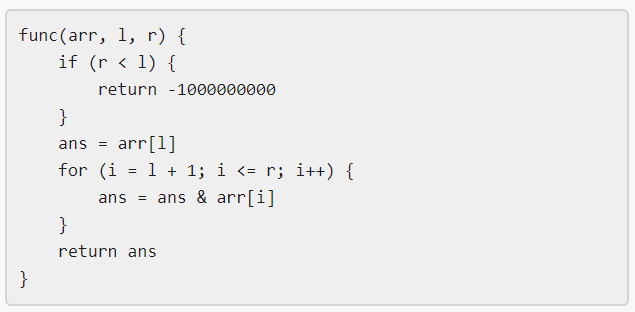Winston was given the above mysterious function func. He has an integer array arr and an integer target and he wants to find the values l and r that make the value |func(arr, l, r) - target| minimum possible.
Return the minimum possible value of |func(arr, l, r) - target|.
Notice that func should be called with the values l and r where 0 <= l, r < arr.length.
Input: arr = [9,12,3,7,15], target = 5 Output: 2 Explanation: Calling func with all the pairs of [l,r] = [[0,0],[1,1],[2,2],[3,3],[4,4],[0,1],[1,2],[2,3],[3,4],[0,2],[1,3],[2,4],[0,3],[1,4],[0,4]], Winston got the following results [9,12,3,7,15,8,0,3,7,0,0,3,0,0,0]. The value closest to 5 is 7 and 3, thus the minimum difference is 2.
Input: arr = [1000000,1000000,1000000], target = 1 Output: 999999 Explanation: Winston called the func with all possible values of [l,r] and he always got 1000000, thus the min difference is 999999.
Input: arr = [1,2,4,8,16], target = 0 Output: 0
1 <= arr.length <= 1051 <= arr[i] <= 1060 <= target <= 107
impl Solution {
pub fn closest_to_target(arr: Vec<i32>, target: i32) -> i32 {
let n = (*arr.iter().max().unwrap() as f64).log2().ceil() as usize;
let mut prefix_zeros = vec![vec![0; n]; arr.len() + 1];
let mut ret = i32::MAX;
for i in 0..arr.len() {
for j in 0..n {
prefix_zeros[i + 1][j] = prefix_zeros[i][j] + 1 - ((arr[i] >> j) & 1);
}
}
for r in 0..arr.len() {
if arr[r] <= target {
ret = ret.min(target - arr[r]);
continue;
}
let mut x = 0;
let mut lo = 0;
let mut hi = r;
while lo < hi {
let mid = (lo + hi) / 2;
x = (0..n)
.filter(|&i| prefix_zeros[r + 1][i] - prefix_zeros[mid][i] == 0)
.fold(0, |acc, i| acc | (1 << i));
if x == target {
return 0;
} else if x < target {
lo = mid + 1;
} else {
hi = mid;
}
}
x = (0..n)
.filter(|&i| prefix_zeros[r + 1][i] - prefix_zeros[hi][i] == 0)
.fold(0, |acc, i| acc | (1 << i));
ret = ret.min((x - target).abs());
if hi > 0 {
x = (0..n)
.filter(|&i| prefix_zeros[r + 1][i] - prefix_zeros[hi - 1][i] == 0)
.fold(0, |acc, i| acc | (1 << i));
ret = ret.min((x - target).abs());
}
}
ret
}
}